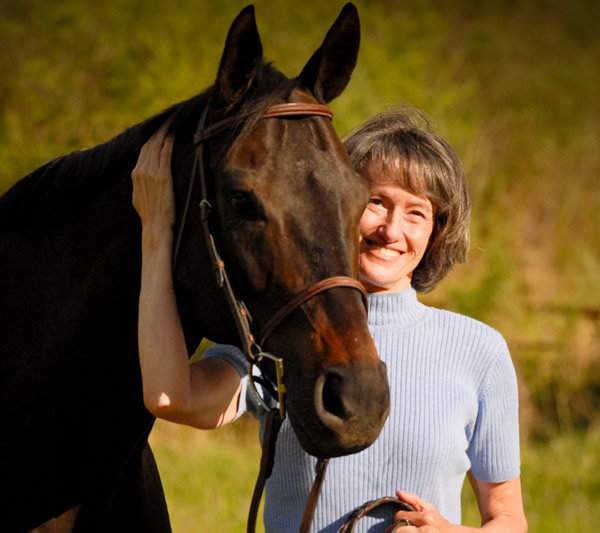TRUE TRAINING 107 - "Horses Can't Learn That!"
Feb 01, 2025 by Janet Jones
I hear that phrase a lot when I encourage people to teach their horses desired behavior instead of just expecting them to figure it out. An earlier post (#50) in this blog when True was learning how to be vacuumed is an example.
Horses can be taught not to kick the walls of their stalls, to come when called (Posts #2 and 3), to wait in one spot while a rider walks away to carry out some task, to halt square from any gait, or where to urinate and where not to. (Even cows can be trained where to pee.) The problem is not usually an animal’s inability to learn, it’s the human’s unwillingness to try. The other day I stumbled on another instructional success with a mare who was beckoning to True throughout his training session.
Two sides of the arena we use most often are located in a very large pasture containing about 15 mares. A common fence blocks these two arena sides from the pasture. Thanks to unusually warm weather this winter, some of them recently came into heat. They all love True, and as you know from previous posts, he loves them. One in particular—Chica—seemed to have her heart set on a tryst.
As I was riding True in the arena, Chica would not leave the common fence. Hanging her head over the top, she nickered to True about every ten seconds as he circumnavigated the ring. Each time we got to her location, she followed him. At least twice on each pass, she stopped, turned her hindquarters to the fence, squealed, nickered some more, winked, and wiggled around.
I waved a crop at Chica and scolded her with my voice, hoping she would set up shop someplace else in the 35-acre pasture. Zero effect. Trouper did a good job of minding his manners and obeying my requests, but he was definitely distracted. I felt Chica’s behavior presented a level of interference that we did not need. Now, most people would say, “well there’s nothing you can do about that.” But I’ve heard that statement a lot in my life and enjoy proving it wrong. That one, and “it can’t be done” are among my favorites.
So, I dismounted, climbed over the pasture fence, and shooed Chica away with my arms and voice, uphill for about a hundred yards. I made sure she stayed there while I walked back down to the arena, where True was waiting patiently. Hopped back on. Guess who was back at the fence in about five minutes? I dismounted again and repeated my lesson.
Chica did not approach again for the remaining 45 minutes of our ride. She stood a hundred yards distant, facing our way, and watched True silently. At one point, another of the mares approached us. Chica just watched. When we were finished with our ride, I led True from the arena, and at that point Chica approached the fence.
The next day, Chica stayed away until we finished our work. I didn’t have to wave the crop or dismount and shoo her along; she stayed away on her own. She did the same on the following day with only one reminder from me. We’ll see what happens in coming weeks. Horses can learn all sorts of surprising things if we just give them the chance and use effective teaching techniques.
Horses can be taught not to kick the walls of their stalls, to come when called (Posts #2 and 3), to wait in one spot while a rider walks away to carry out some task, to halt square from any gait, or where to urinate and where not to. (Even cows can be trained where to pee.) The problem is not usually an animal’s inability to learn, it’s the human’s unwillingness to try. The other day I stumbled on another instructional success with a mare who was beckoning to True throughout his training session.
Two sides of the arena we use most often are located in a very large pasture containing about 15 mares. A common fence blocks these two arena sides from the pasture. Thanks to unusually warm weather this winter, some of them recently came into heat. They all love True, and as you know from previous posts, he loves them. One in particular—Chica—seemed to have her heart set on a tryst.
As I was riding True in the arena, Chica would not leave the common fence. Hanging her head over the top, she nickered to True about every ten seconds as he circumnavigated the ring. Each time we got to her location, she followed him. At least twice on each pass, she stopped, turned her hindquarters to the fence, squealed, nickered some more, winked, and wiggled around.
I waved a crop at Chica and scolded her with my voice, hoping she would set up shop someplace else in the 35-acre pasture. Zero effect. Trouper did a good job of minding his manners and obeying my requests, but he was definitely distracted. I felt Chica’s behavior presented a level of interference that we did not need. Now, most people would say, “well there’s nothing you can do about that.” But I’ve heard that statement a lot in my life and enjoy proving it wrong. That one, and “it can’t be done” are among my favorites.
So, I dismounted, climbed over the pasture fence, and shooed Chica away with my arms and voice, uphill for about a hundred yards. I made sure she stayed there while I walked back down to the arena, where True was waiting patiently. Hopped back on. Guess who was back at the fence in about five minutes? I dismounted again and repeated my lesson.
Chica did not approach again for the remaining 45 minutes of our ride. She stood a hundred yards distant, facing our way, and watched True silently. At one point, another of the mares approached us. Chica just watched. When we were finished with our ride, I led True from the arena, and at that point Chica approached the fence.
The next day, Chica stayed away until we finished our work. I didn’t have to wave the crop or dismount and shoo her along; she stayed away on her own. She did the same on the following day with only one reminder from me. We’ll see what happens in coming weeks. Horses can learn all sorts of surprising things if we just give them the chance and use effective teaching techniques.

